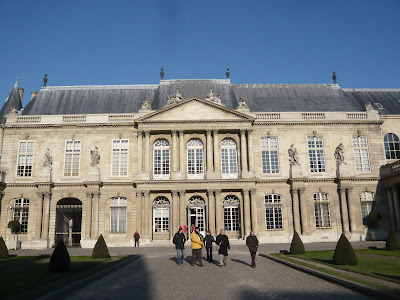 |
| Hôtel de Soubise in Paris |
Patrick Damiaens
Ornamental woodcarver
Hôtel Soubise in Paris
Visiting Museums and Castles is Probably the main source of inspiration for the Ornamental Woodcarver.
These are places where the craftsman gets his ideas, he is looking for new challenges and always new unexpected surprises, and even after 25 years still feels something new to learn.
These are places where the craftsman gets his ideas, he is looking for new challenges and always new unexpected surprises, and even after 25 years still feels something new to learn.
Exploring and studying ,looking at problems and how your colleagues 300 years ago solved them, their knowledge of tasteful proportions used in the interior decoration and their knowledge of carving techniques.
We visit ' The Hôtel de Soubise ' in Paris
The Hôtel de Soubise is a city
mansion entre cour et jardin, located at 60 rue des Francs-Bourgeois, in
the 3rd arrondissement of Paris.
The Hôtel de Soubise was built for the Prince and Princess de Soubise on the
site of a semi-fortified manor house named the Grand-Chantier built in
1375 for connétable Olivier de Clisson, that had formerly been a
property of the Templars.
 |
| Panelled rooms | The HOTEL DE SOUBISE in PARIS |
 |
| 18th Century Interiors | Carved Panelling |
The site previously contained the Hôtel de Guise, the
Paris residence of the Dukes of Guise, a cadet branch of the House of Lorraine.
It was the birthplace of the last Duke, Francis Joseph, Duke of Guise, the son
of Élisabeth Marguerite d'Orléans, Duchess of Alençon. He died in 1675 and the
Guise estate passed to Marie de Lorraine who died at the Hôtel in 1688 having
been born there in 1615.
On March 27, 1700, François de Rohan, prince de Soubise bought the Hôtel de
Clisson, lately de Guise, and asked the architect Pierre-Alexis Delamair to
remodel it completely. Works started in 1704. His wife Anne de Rohan-Chabot,
one time mistress of Louis XIV (their affair is thought to have funded the
purchase of the building) died here in 1709.
 |
| 18th Century Interiors | Soubise Paris |
Hercule Mériadec, Prince of Soubise (son of François) was responsible for
some interior décor at the Hôtel de Soubise engaging Germain Boffrand in the
process. This dates from the 1730s. Improvements were made to celebrate the
marriage of Hercule Mériadec to Marie Sophie de Courcillon, grand daughter of
the famous marquis de Dangeau.
It was the home of Louis XV's friend Charles de Rohan, prince de Soubise; his
daughter Charlotte Élisabeth Godefride de Rohan, future princesse de Condé was
born here in 1737 as was the Princess of Guéméné in 1743.
Interiors by Germain Boffrand, created about 1735–40 and partly dismantled,
are accounted among the high points of the rococo style in France (Kimball
1943: 178). They constituted the new apartments of the Prince on the ground
floor and the Princesse on the piano nobile (noble floor), both of which featured oval
salons looking into the garden.
 |
| Carved panelling painted and gilded |
These rooms that have changed very little since
the 18th century, including the Chambre du prince, Salon ovale du prince, Chambre d'apparat de la princesse and the very fine Salon ovale de la princesse with gilded carvings and mirror-glass embedded in the boiserie (paneling) and ceiling canvases and overdoors by François Boucher, Charles-Joseph
Natoire, and Carle Van Loo.
Since a Napoleonic decree of 1808, this residence has become the property of
the State. Nowadays it hosts the Musée de l'Histoire de France (Museum of
French History) and a part of the French National Archives.
 |
| Carved panelling painted and gilded |
Pictures, Patrick Damiaens
Source, Wikipidea






No comments:
Post a Comment